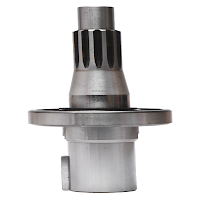Vane Pump : Vane pumps are available in a number of vane configurations including sliding vane (left), flexible vane, swinging vane, rolling vane, and external vane. Vane pumps are noted for their dry priming, ease of maintenance, and good suction characteristics over the life of the pump. Moreover, vanes can usually handle fluid temperatures from -32°C / -25°F to 260°C / 500°F and differential pressures to 15 BAR / 200 PSI (higher for hydraulic vane pumps). Each type of vane pump offers unique advantages. For example, external vane pumps can handle large solids.Flexible vane pumps, on the other hand, can only handle small solids but create good vacuum. Sliding vane pumps can run dry for short periods of time and handle small amounts of vapor. How Vane Pumps Work : Despite the different configurations, most vane pumps operate under the same general principle described below. 1. A slotted rotor is eccentrically supported in a cycloidal cam. The rotor is located cl...



